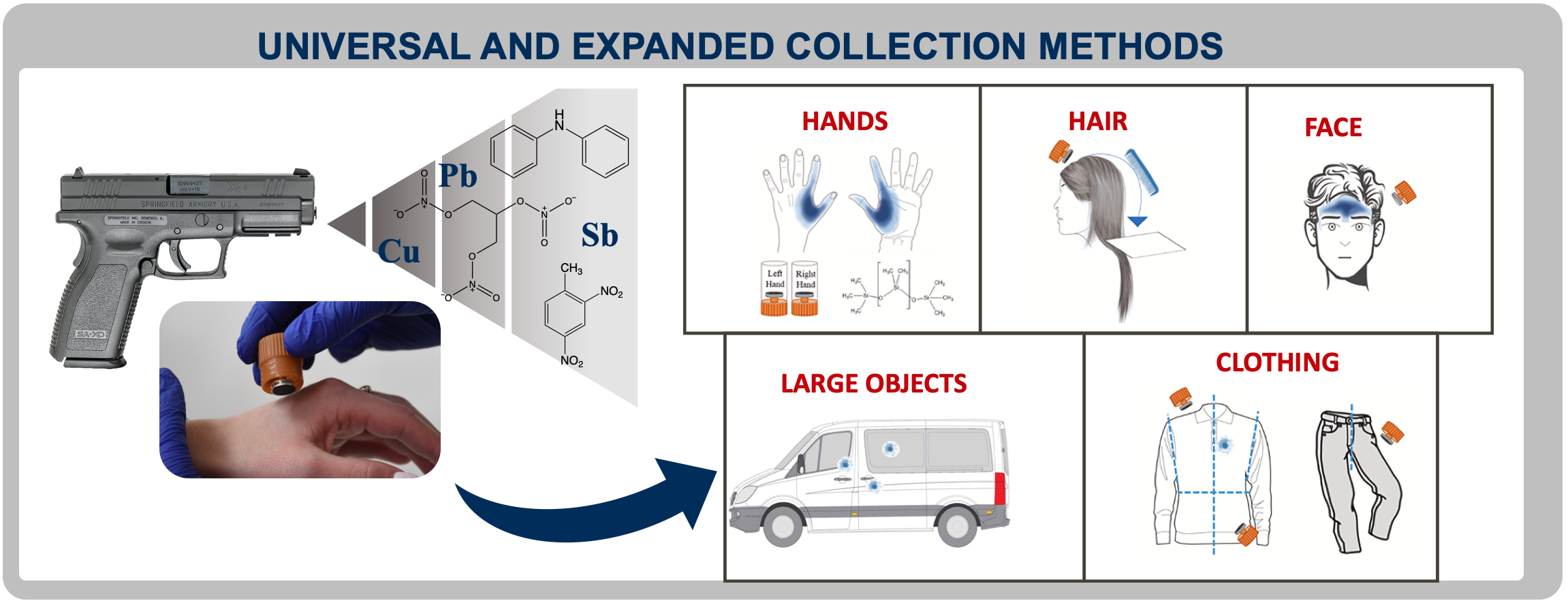Innovation in forensic science is critical to the swift and equitable administration of justice. Analysis of gunshot residue (GSR) can provide valuable investigative information in cases involving firearms, such as homicides, mass shootings, terrorism, suicides, and accidental shootings. But when it comes to the traditional methods of GSR detection, the field has struggled with challenges regarding the speed of analysis, the accuracy of results, and the applicability to new ammunition types. There is, consequently, a critical need to develop methods that can shorten residue testing time and increase certainty in order to protect the public and help investigators make informed decisions based on reliable data.
Establishing methods for GSR analysis that have demonstrable error rates is challenging. The residue comprises organic components, which arise from the propellant and lubricant; and inorganic components, which arise from the primer, bullet, and cartridge casing. However, current methods using scanning electron microscopy and energy dispersive spectroscopy only analyze the inorganic components, require expensive laboratory instrumentation, and require hours to scan a single sample.
NIJ-funded researchers from West Virginia University sought to develop a comprehensive strategy to improve the detection and analysis of GSR to include both inorganic and organic components. Tatiana Trejos, Luis Arroyo, and colleagues posited that two techniques, electrochemical detection and laser-induced breakdown spectroscopy, could analyze GSR samples faster, more selectively, and yield more information than current laboratory-based and field tests.
Their research focused on:
- Developing versatile and fast methodologies for detection of GSR on hands and other surfaces.
- Applying statistical methods for the probabilistic interpretation of GSR evidence.
Unprecedented Dataset Helps Assess Value of Novel Screening Techniques
Trejos’ group collected a sample set of gunshot residues from the hands of shooters and non-shooters, a variety of surfaces, and the environment (see Figure 1) to develop and validate the use of electrochemical detection and the laser-induced breakdown spectroscopy screening method. What resulted is the most extensive GSR dataset ever reported from a single study. Researchers used exploratory and descriptive statistical analysis, significance tests, machine learning algorithms, and classifier methods to assess the relative value of novel screening techniques and to evaluate their ability to predict class membership (i.e., shooter versus non-shooter subpopulations).
The dataset included:
- Organic and inorganic GSR profiles on various populations and substrates.
- Over 3,200 samples, recovered from the hands of more than one thousand individuals and from over 200 fabric, glass, wood, and drywall surfaces.
The two screening techniques (electrochemical detection and laser-induced breakdown spectroscopy) were found to be quicker than previous methods (see Figure 2), permitting the identification of organic and inorganic residues with 92-99% accuracy — highly accurate for a screening technique.[1] Moreover, the techniques are practically non-destructive of the samples, allowing follow-up with confirmatory techniques to validate the results.
These novel methods are versatile, and could be applied for various purposes, such as:
- Detection of GSR on the hands of an individual of interest in an investigation.
- Determination of shooting distances.
- Identification of residues on bullet holes of various substrates encountered in crime scenes.
Sample Capture: Surpassing the Goal
The COVID pandemic prevented the sampling of GSR from the hands of volunteers for several months, and one confirmation technique (scanning electron microscopy combined with energy dispersive x-ray spectroscopy) took the researchers longer than expected to complete. Nevertheless, their sample processing goal was nearly doubled, as:
- Their initial estimate was to process 640 samples: 375 from hands, 165 from fabrics and glass windows, and 100 control samples.
- They ultimately collected a total of 1611 samples: 3300 from hands, 270 from fabrics, glass, wood, and drywall, and over 380 control samples.
Modernization of Gunshot Residue Analysis
The researchers developed a comprehensive approach to overcome the major concerns related to GSR analysis. Unlike most forensic fields, in GSR, screening tests are not currently available. The researchers sought to add screening testing into the current casework workflow to assist with more cost-effective case management.
A highly accurate screening tool allows for more effective decision-making processes at the crime scene and at the laboratory. For instance, rapid screening allows for more informed decisions on what samples to collect and can assist with backlog reduction, faster turnaround times, and increasing confidence in results. This has potential to increase the utility of GSR evidence in the criminal justice system, which can be critical for reconstructing the events of a crime, providing investigative leads, and determining which evidence is strong enough to be admitted in court.
The new methods allow the detection of organic and inorganic GSR components in under five minutes per sample with high accuracy. This fast, dual-detection methodology creates a new path for addressing court-relevant queries regarding the firing of a weapon. Objectivity and impartiality are bolstered by the application of data-driven statistical methods using machine learning classification and the calculation of likelihood ratios to quantify the value of the evidence.
This ground-breaking approach to the detection and interpretation of GSR has the potential to modernize current practice and pave the way to more reliable processes in shooting investigations. The relatively low cost (as compared to scanning electron microscopy) and availability of handheld laser-induced breakdown spectroscopy should facilitate adoption of the workflow developed for gunshot residue detection.
About This Article
The work described in this article was supported by NIJ award number 2018-DU-BX-0186, awarded to West Virginia University.
This article is based on the grantee report “Fast screening of firearm discharge residues by laser-based spectrochemical methods, electrochemical sensors, and chemometrics” (pdf, 76 pages), by Tatiana Trejos, Luis Arroyo, Korina Menking-Hoggatt, Colby Ott, Courtney Vander Pyl, William Feeney, Kourtney Dalzell, West Virginia University, Department of Forensic and Investigative Science.



